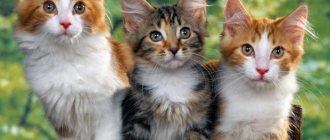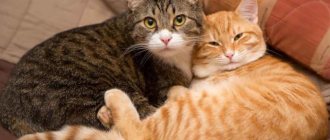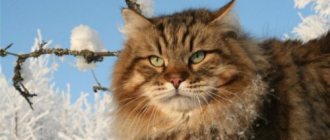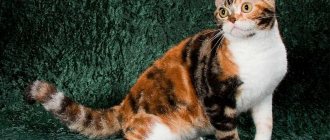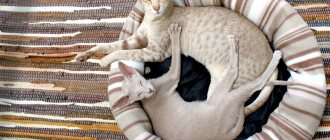Appearance characteristics
Solidity and impressiveness - these epithets perfectly describe the appearance of a nimble cat, which, it seems, will resemble a cute and fluffy kitten until old age. The Pampas cat breed has the following external features:
- The head is round in shape, massive and wide with a convex and expressive forehead.
- The nose is large in size, due to which it stands out well on the muzzle.
- The ears are triangular, high placed. A contrasting line runs along the edge of the fur of the ears.
- The eyes are of medium diameter, the pupils are located vertically.
- The body is up to 75 cm long, the weight of an adult is from 3 to 6 kg, males are heavier than females.
- The paws are muscular and quite short (when compared with other feline representatives), the feet are wide, and the claws are retractable.
- The tail is about 25 cm long.
- Wool – very dense, the length of the fibers is 7 cm. Depending on the habitat, the wool can have a different color.
Most representatives of the breed are gray in color with a brownish tint. In addition, there are individuals with a red tint to their fur; there are also Pampas cats whose fur has a rich black color, but this is most likely an exception to the rule.
The animal's muzzle is very cute, its mouth has a peculiar shape that resembles a smile. But such cuteness is very deceptive - the animal cannot stand communicating with strangers, showing with all its appearance that it will behave aggressively if its privacy is interfered with.
Inhabitant of the South American steppes
The priest Juan Ignacio Molina first spoke about the dwarf wild cat, which lives in the bushes on the rocky slopes of the Andes. He was forced to emigrate to Italy, where in 1782 he published a book about the plants and animals of his homeland, Essay on the Natural History of Chile. The scientist decided to name the inhabitant of the pampas “bell”, which means “mountain cat” in the language of the Araucan Indians. This name was borne by the brave leader of the local tribe, who died in 1515 in a battle with the Spanish conquerors. In modern classification, the tiny furry predator has the Latin designation Leopardus colocolo and belongs to the subfamily of small cats (Felidae). American zoologists classify this species of animal in the genus Oncifelis, which sometimes causes confusion in the name of the wild cat.
The Pampas cat is found in most countries in South America. The stony plains fur trade flourished until 1987. At the same time, the last authorized batch of skins in the amount of 10 thousand pieces was sold. This measure saved the species from complete extermination. The furry animal is included in the International Red Book as endangered. The population of the small predator is stable only in Argentina, where its original habitats are protected in 9 nature reserves. In the biological parks of Peru and Brazil, steppe cats are very rare, and in Uruguay their presence has not been recorded for 10 years.
Features of life in the wild and hunting
Representatives of the Pampas breed are distinguished by excellent auditory and visual characteristics.
Their vision reaches its maximum sharpness during the period of pitch darkness, when the animals go hunting. The cat is dexterous and flexible; it has no difficulty for her to climb the sloping branches of tall trees.
For shelter and rest, cats choose crevices in rocks, between tree roots rising above the ground, and also feel comfortable in bushes with high branches and lush leaves. Each individual has its own territory, which averages about 30 km2. The cat marks the occupied territory, irrigating the grass with drops of urine.
If a Pampas cat feels danger and a threat to its life, its fur begins to stand on end, the animal turns into a solid “ball” of hair. The cat prefers not to enter into open confrontation with enemies, so in moments of greatest danger he sits out on a tall tree. If there are no high branches nearby, the cat is saved by the fact that it can run fast.
The animal hunts at any time of the day, but still prefers the night. Thanks to the excellent functioning of the visual organs, the cat easily tracks the victim by tracks and scent. The furry hunter overtakes the chosen victim with several large jumps, a couple of meters long. Unlike most cats, the Pampas breed does not waste time sitting on the victim for a long time, preferring to overtake it and knock it down, while latching its teeth into the neck.
If you watch a cat for a long time, you get the impression that it is clumsy and short-legged, and cannot seem to be an excellent hunter. But this particular breed is considered the best hunter among other medium-sized cats. The animal attacks its target so quickly and swiftly that it does not have time to understand anything.
Who is in the “enemy” camp
In the wild, the Pampas cat is afraid only of large birds, predators larger than itself, and humans. This predator has always been the target of poachers. This is due to the thick and beautiful fur of the animal, from which fur coats were made. Due to the fact that the breed was hunted for a long time, the species at one point was on the verge of complete extinction, the population size decreased so much.
Today the population of the Pampas breed numbers about 50,000 individuals. These data are highly generalized, since the animal leads a secretive lifestyle, which makes it difficult to observe it for a long time.
In 1987, it was prohibited by law to hunt Pampas cats for the purpose of extracting fur and selling it to private owners.
This law took effect, and the breed population was partially restored.
Pampas cat: interesting facts and information
In the CIS countries, they learned about the grass cat only in our days, since it was identified as a separate species not so long ago. It is distinguished from other brethren by the structure of the skull and the characteristics of its coat. But despite this, some zoologists refuse to recognize the Pampas cat as a separate species. Despite the fact that this animal has been known in its homeland for a long time, there are no published detailed studies and observations about it. So, there are still no details related to the reproduction of these furry animals. The enemy of the Pampas cat is large birds of prey and animals, as well as people who hunt them for their skins.
Nutrition
The diet of the Pampas cat consists of small rodents and small birds. If the hunt for rodents was unsuccessful, or the cat wanted to treat itself to a new menu, then they do not hesitate to feast on insects and non-poisonous reptiles.
The Pampas breed is quite neutral towards people with whom it often lives close. But people don’t like being around furry predators. The reason for this is that the cat preys on poultry, often destroying farmland.
Find out what other breeds of wild cats exist:
- black-footed cat;
- manul;
- dune cat
Area
The Pampas cat lives in South America. It can be found in Chile, Brazil, Uruguay, Argentina. She settles in the foothills of the Andes, where she can climb to a peak whose height reaches 5 thousand meters above sea level. In these places they prefer to settle in grassy areas. These are the steppes and pampas (fertile plains with flat topography). It is thanks to their habitat that cats got their name. Animals do not like mangrove swamps, wet forests, or thickets of dried thorny bushes, although they are occasionally found there.
Continuation of the family line
Pampas cats are typical solitary cats of the wild. They live exclusively solitary lives; females and males unite only during the mating period. After mating, the male leaves the female, and they no longer see each other. All care for the offspring is entrusted to the female, who first feeds the cubs with milk, and then begins to accustom them to food of animal origin and teach them hunting skills.
Pregnancy lasts for a long time, about 3 months. Kittens in a litter are large in size, which is why only 1-2 of them are born. In extremely rare cases, a litter consists of 3 kittens. Kittens need the constant presence of their mother until they are 6 months old.
Behavior
Photo: Kilverstone Wildlife Park
Cats of this species are predominantly nocturnal. Wild individuals were observed to be active during the day. In addition, it should be noted that the male in the Zoological Park of Goania (Brazil) climbed trees well and spent most of his time resting on their tops. Very little is known about the social structure and connections of Pampas cats. When excited, in specimens living in captivity, a rise in hair along the midline from head to tail was observed.
Features of living in captivity
Pampas cats are outwardly quite cute and fluffy animals, so because of this appearance, one gets the misleading impression that they are very kind and affectionate. It is almost impossible to tame this wild hunter as a pet. However, some lovers of exotic breeds want to get a Pampas cat without fully realizing what awaits them.
Life in captivity, whether in a zoo, nursery, or private property, is accompanied by a difficult period of acclimatization for the animal. Being taken out of natural conditions, the animal experiences severe stress, which negatively affects its immune system and health.
At first, a cat that ends up in a zoo, even though all conditions will be created for it, behaves with increased aggression and is constantly nervous.
In captivity, an animal does not produce offspring, and if an adult individual has been deprived of its natural habitat, it will not be possible to change its behavior and accustom it to life in new conditions.
If you want to get a Pampas cat, you need to equip a large enclosure for him outside. Representatives of this breed are completely unsuitable for living in an apartment, only in a private house with a large local area. Food – fresh, lean meat, fish. Industrial feeds are excluded from the animal’s diet.
If you decide to have this breed of cat as a pet, you should understand that you won’t be able to play with it. An animal, no matter how comfortable living conditions are created for it, will never abandon its wild habits and will not make contact with humans, remaining only a furry resident of an enclosure with an unkind and nervous character.
Pampas cats who were forced into captive conditions at a tender age adapt more easily. But as they grow older, their natural instincts and savage character will manifest themselves more and more.
Puberty and reproduction
Very little is known about the reproduction of Pampas cats in natural conditions due to the high secrecy of these representatives of the cat family. For the most part, scientists have made some conclusions only by observing a few animals living in captivity.
In zoos, the mating season for Grass cats occurs in April-July. At this time, males are very active, they have constant battles in the struggle to mate females.
Pregnancy lasts quite a long time, from 75 to 85 days. It ends with the birth of a litter, in which there are from one to four kittens, but usually there are two or three.
Babies weigh 100-130 grams and suckle their mother for up to 3-4 months. After 10-14 days, their eyes open, and from the second they begin to actively move, crawl out of the den and play. At two, they are fed with the meat that their mother gets for them; at four, the female begins to teach them hunting skills. At six months the animals become completely independent and are able to live alone.
Puberty occurs towards the end of the second year of life.
There are known cases of Pampas cats living in captivity for up to sixteen years; in their natural habitat, life expectancy is apparently much shorter.


